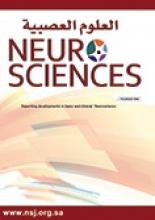Abstract
OBJECTIVE: The aim of this work is to find out factors that affect the outcome of treatment of patients with craniopharyngioma treated at King Khalid University Hospital, Riyadh, Kingdom of Saudi Arabia.
METHODS: This study was carried out retrospectively by reviewing the medical records of all patients with craniopharyngiomas treated at King Khalid University Hospital, Riyadh, Kingdom of Saudi Arabia in the last 10 years (January 1990 through to December 1999), and collecting clinical, radiological, surgical, and follow-up data and performing statistical analysis to find out factors that affect the outcome of such cases.
RESULTS: There were 11 females (61%), and 7 males (39%), the median age was 24 years. The main presenting symptoms were reduced vision in 66.7%, symptoms of raised intracranial pressure in 50%, endocrinal problems in 33.3%, seizures in 16.7%, and hemiparesis in 5.6%. Radiologic studies showed 72% of tumors had mixed solid and cystic components, calcification in 83%, and ventricular dilatation in 50% of cases. The tumor extended to the posterior fossa in 11%, and to both middle and posterior fossae in 11% of cases. Eighty-nine percent of patients had tumor excision through pterional craniotomy and 11% through subfrontal approach. Gross total removal was achieved in 17% and subtotal resection in 83%. Tumor recurred in 9 patients (50%), 4 of them (44%) had postoperative radiotherapy. The outcome was good in 10 patients (56%), poor in 6 patients (33%), and 2 patients died (11%). The patient age, radiological appearance of tumors and their location were significantly correlated with the outcome (p 0.02, 0.02, 0.04).
CONCLUSION: Craniopharyngiomas are a common tumor in children. Ophthalmologists and Pediatricians should be aware of the clinical presentation and refer patients to specialized centers for treatment. Total resection of the tumor should be the goal of the Neurosurgeon as it offers the best chance of cure.
- Copyright: © Neurosciences
Neurosciences is an Open Access journal and articles published are distributed under the terms of the Creative Commons Attribution-NonCommercial License (CC BY-NC). Readers may copy, distribute, and display the work for non-commercial purposes with the proper citation of the original work.






